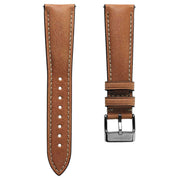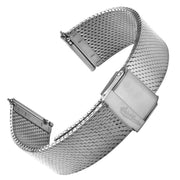It’s 3D printed. It’s titanium. It looks like it was spun by a spider in a dystopian sci-fi lab. Meet the Apiar Gen 1.0 Dawn & Dusk—a timepiece so unapologetically strange, so deeply rooted in British engineering, and so off-the-wall in its design that it’s left me not entirely sure whether I love it, fear it, or both.
This might just be the most ambitious—and bizarre—British microbrand debut in years. But is it actually any good?
A Very British Experiment
Let’s start with the basics: this is a very British watch. Not as a superficial branding claim, but in actual manufacturing. The case, bezel, dial, buckle, strap, and even the pad-printing on the crystal are all done in the UK. That’s no small feat for a microbrand—especially when even the big names struggle with domestic production.
Sure, some parts come from overseas—the crown and sapphire crystal are Japanese, the hands are made in India, and the movement is Swiss—but the overall picture is impressively homegrown.
So yes, it’s British. But does that make it better? Not necessarily. But it certainly makes it more interesting.

3D Printing Isn’t Just for Plastic Toys
Central to the Gen 1.0’s identity is its case construction. Made from Grade 23 titanium via Laser Powder Bed Fusion—a process that builds the case layer by microscopic layer—this is not your average CNC-machined case. The result is a geometry that’s pretty much impossible to achieve using traditional methods. It looks alien. Almost like the exoskeleton of a mechanical spider. It’s weird—and also very cool.
Despite being all-metal, the watch is featherlight. So light, in fact, that more than one person I handed it to assumed it was plastic. The lack of heft is disorienting at first, especially when paired with its skeletal aesthetic. But once it’s on the wrist, it’s surprisingly comforting—low-profile, unintrusive, and easy to forget you’re even wearing it.
Size-wise, the watch hits a sweet spot: 39mm wide, 9.2mm thick, and 20mm between the lugs. On my 6.5-inch wrist, it wears perfectly. The splayed lugs and open profile help it hug the wrist closely, while keeping visual weight to a minimum. And while the case shape is wild, the overall footprint is restrained. It doesn’t scream for attention from across the room—but up close, it absolutely rewards inspection.
Movement & Mechanical Matters
Powering the watch is the Lajoux-Perret G101, a Swiss automatic movement with 24 jewels and a generous 68-hour power reserve. It’s the same calibre used by respected brands like Fears, so you know it’s not some anonymous budget engine.
There are no published accuracy specs, and to be honest, you won’t be admiring it through a caseback—because there isn’t one. The caseback is solid, in keeping with the industrial theme. The only quirk? It’s a little noisy. You may notice the rotor doing its thing more than usual, but it’s not a dealbreaker—just something to note.

The Dial: A Web of Depth and Detail
Now let’s talk about the real star of the show. The dial is nothing short of hypnotic. It features a raised, geometric web structure that echoes the case’s sci-fi energy and adds a serious dose of depth. It’s the kind of dial that begs for macro shots and natural light. Visually dense, layered, and slightly unnerving—but also incredibly cool.

That web pattern isn’t just decorative either—it’s split into twelve segments, so it subtly doubles as your hour markers. There’s no lume, but the nickel-plated hands are well proportioned and contrast nicely against the dark, shadowy dial. I did find myself wishing for rhodium plating at this price, but the contrast is still strong enough to make reading the time surprisingly easy.
It’s dystopian, yes—but beautiful too. Somewhere between Lovecraft, Giger, and brutalist architecture, this is a dial you won’t forget.
Is It Too Weird for Its Own Good?
Look, this watch isn’t going to be for everyone. It’s a first-gen product, and it does show some prototype-level quirks: a rough edge here, a misaligned screw there.
The good news? I only handled a prototype—and I’ve been assured that all these early-stage quirks will be addressed and refined before full production. And crucially, that refinement won’t come at the cost of the design’s ambition.
Because at the same time, this is exactly the kind of thing microbrands should be doing: pushing boundaries, exploring new materials, and giving enthusiasts something they’ve never seen before. It’s bold, it’s British, and it’s got more personality than most watches three times the price.

Final Verdict: Experimental, British, Brilliant?
At £2,250 including VAT, it’s priced firmly in the premium microbrand category. It’s a lot to spend on what some might see as a design experiment. That’s the trade-off: this isn’t a safe choice. It’s not timeless or traditional or versatile. It’s specific. It’s bold. It’s divisive.
But when you factor in the UK manufacturing, the 3D printed titanium, the unusual design language and the bespoke feel, it starts to look like decent value—if you’re the right customer.
It’s light, loud, visually outrageous and proudly local. It feels like a design student’s fever dream executed with aerospace precision—and honestly, I respect the hell out of that. I don’t know if I’d wear it every day, but I do know I’ll be sad to give it back.
If you’re looking for a watch that sparks conversations and stands apart from the sea of vintage reissues and generic dive watches, this might just be your next horological obsession.











